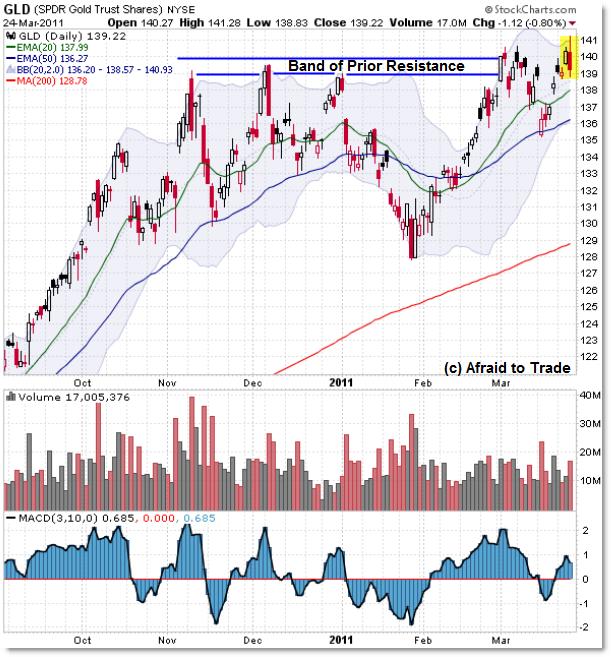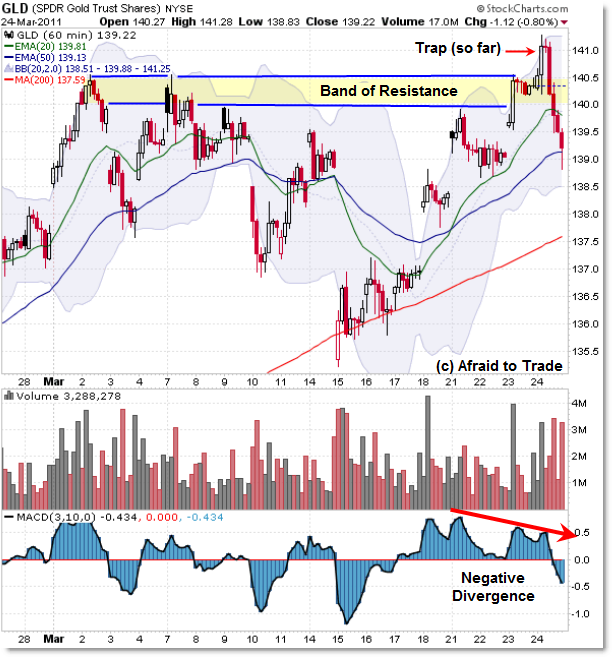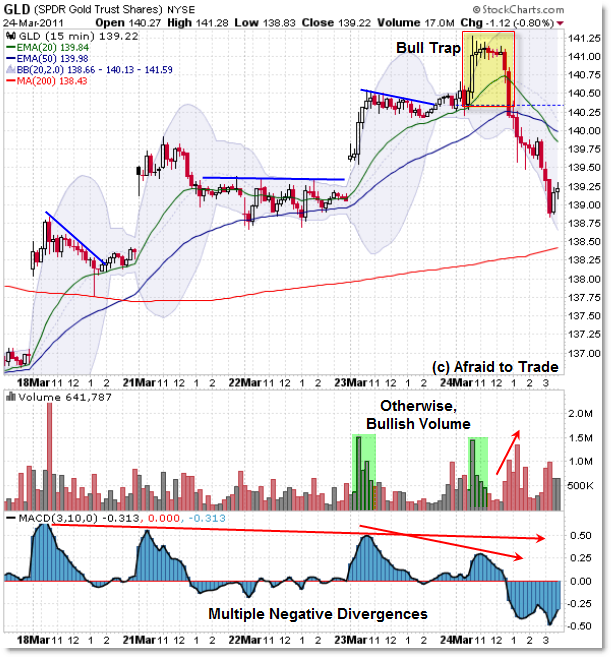Stepping Inside the Bearish Engulfing Bull Trap in Gold GLD
Wow – what a turn-around intraday in gold prices! Buyers who purchased gold or the GLD ETF on the breakout to new highs in the morning session were cursed with a mid-day reversal that triggered a Bull Trap that created an ominous looking Bearish Engulfing Candle on the daily chart.
Let’s take a moment to look at the daily chart then step inside today’s intraday action to see what went wrong and learn a lesson in protection when the obvious play becomes a vicious trap.
First, the bigger picture from the Daily Chart:

First of all, I’m showing GLD – the popular GLD ETF on the daily structure.
I’ve mentioned this in weekly reports and I believe in a blog post, but the recent action in gold has concerned me – namely that gold pushed up to a new lifetime breakout high in early March but failed to sustain it.
This kind of behavior is a non-confirmation by price action and is inherently a caution/warning signal. We typically expect new breakout highs to be met with a rush of buyers which are joined with a frantic rush of short-sellers being forced to buy to cover their losses as price breaks through their protective stop-loss levels.
A breakout that fails to trigger an immediate feedback loop of upside action is suspect and must be monitored very closely. Gold seems to be displaying this non-confirm or “unexpected” breakout failure action at the moment and must therefore be watched objectively and closely.
No, it’s not true that every single bearish engulfing candle results in a trend reversal, but while price remains under the candle formation at the $139 to $141 level, then gold is in potential danger of a steeper pullback.
A firm breakout – accompanied with higher volume and momentum – negates these signals and puts them behind us, but while they exist, you’ll need to watch your open positions much more closely than otherwise.
Here, let’s step inside the hourly chart to see the progression up and today’s stunning reversal:

Here’s the recent ‘failure’ breakout to new highs in early March which eventually built-up to today’s failure breakout and reversal.
Always pay attention to price relative to momentum and volume – on guard for confirmations (higher price, volume spike/rise, momentum spike/high) or non-confirmations (divergences in volume or momentum with price highs).
Though the first push-up on March 2nd was met with confirming spikes in momentum and volume, the second push on March 7th was NOT. The divergences hinted at a reversal lower (short-term) and that’s what happened – as price fell along with stocks during the Japan situation to the $135.50 level (from $141).
The recent push-up initially was met with higher volume spikes and higher momentum, but the recent ‘second pushes’ on March 23rd and 24th (today) were NOT met with higher momentum – the negative divergence is clear.
That was the structure going into today’s high – that of a weakening of momentum and failure to sustain above the “Resistance Band” I drew from $140 to $140.50.
A breakthrough to new highs WITHOUT a confirmation from volume and momentum is like a handful of troops breaking free from the ranks as they charge ahead into battle, only to look back to see no other soldiers are charging with them. The result is that the eager troops must then fall-back to the safety of the other troops.
Similar things tend to happen in the markets.
Let’s drop down to the 15-min chart to see that momentum was even worse on the lower timeframes:

The 3/10 Momentum Oscillator peaked on March 18th on the gap/surge to the upside. From there, price pushed to three additional highs but each time, the oscillator registered a slightly lower high.
I discuss momentum principles – both leading to the upside and forecasting reversals via divergences – in Chapter 3 of the new Trading Course book (which you may actually be able to read a portion online via Amazon).
Anyway, momentum tends to lead price, and you want to see momentum and price surging to new highs together to have confidence in a successful (high probability) buy trade (of course, relative to your timeframe/holding period).
We did initially have volume spike-up in confirmation on the 23rd and today but today, volume steadily and clearly trailed lower each 15-min period until price reversed.
So how do you protect yourself if you bought a breakout this morning?
First, don’t let your greed/emotion blind you from new price developments.
Watch for our old villains “Ownership Bias” and “Confirmation Bias” to sneak up on you – with these, we tend to ignore conflicting evidence to our position (long). Thus, we might ignore the previous divergences and then ignore the later price breakdowns through rising trendlines and rising moving averages on multiple intraday timeframes.
Namely, price shattered the rising intraday trendline that also happened to be the rising 20 period EMA on the 15-min chart at $140.75. Fifteen minutes later, price deeply sliced under the 50p EMA at $140.25 then under the key $140 level. That should NOT happen if you expect a big impulse breakout to happen.
Also, putting moving averages aside, price shattered under the prior support-level price low at the $140.25 region (from Wednesday).
Price also then sharply broke under the rising 20 EMA on the hourly chart – something also that should NOT happen.
The safety/protection play was to exit on the ‘unexpected’ breakdown under the $140 level – it’s that kind of action that triggers “popped stops,” which create big moves as a result of one side of the market rushing for the exits at the same time.
If you hold and hope during a collapse-down or change in chart psychology, you expose yourself to the potential for a serious and sudden loss.
That’s the main logic of protective stops – place stops under logical price levels (namely confluence support levels) under which price should NOT move. In the event price DOES move under those levels, take your exit gracefully and painlessly as possible.
I’m reminded of one of my favorite axioms of trading wisdom that I frequently share in the daily reports:
“If something SHOULD happen but does NOT, then it often leads to a LARGER than expected move in the OPPOSITE direction.”
Namely because one side of the market is now being unfortunately squeezed out of their positions as the other side capitalizes on this situation, thus creating a temporary but sometimes violent/powerful feedback loop of perpetual motion that cripples those who fight the move in motion.
I’ll leave it at that – trade as normal but always be on guard for surprise actions and know levels ahead of your entry where you will exit.
Today’s action makes gold very suspect – it’ll need to push on to new highs very soon, else it may be in trouble to retest lower support levels soon. Watch very attentively as the next few days progress.
Corey Rosenbloom, CMT
Afraid to Trade.com
Follow Corey on Twitter: http://twitter.com/afraidtotrade
Corey’s new book The Complete Trading Course (Wiley Finance) is now available!

Shorted Gold today….via CFD.
The CME hiked the margin requirements. It has happened before and always leads to a sudden drop in price. The effect is usually relatively short lived, but it certainly scares away a few longs if they don't know what caused it.
Corey, my take a Bearish Engulfing is that the open must be higher than previous close…therefore the entire body must eclipse the entire body of the previous day, on the upside and the downside.
Ahhh – makes sense.
I didn't trade the move and had about 5 emails last night asking me what went wrong and for an update on gold and just spoke from the chart perspective.
True – these sort of events occur on high prices with high speculation and they are designed to reign-in leverage/speculators and – ideally – protect those with small accounts in the event price takes a volatile downturn.
It does pull-out liquidity – but right the down moves tend to balance out shortly after the initial 'shock.' GLD is trading slightly higher this morning.
Stevo,
I look at it in terms of the high and low – which may also be called a wide range engulfing bar. The true bearish engulfing does demand a gap above the prior high which acts as a trap and then closes under the low. That's why I did a step-inside analysis – it's similar logic but the definition isn't as strict.
We still had divergences going into the “trap” that happened Thursday that that was a devastating sell-off for short-term long traders in GLD that broke multiple intraday support levels.
This morning had a 4th wave up after 3 down from a double top yesterday.
I think Silver is in a 4th wave on the 60 min chart. 4th of a 5th wave. What do you think?
Thanks for the clarify, and sure appreciate your blog